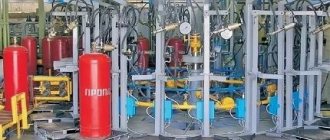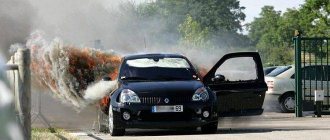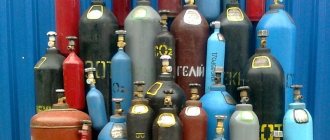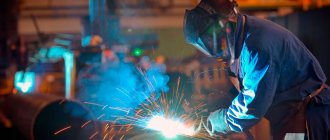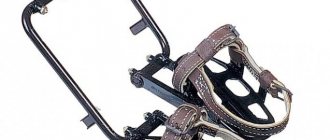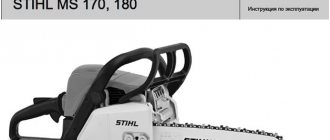Checking the gas cylinder
Inspection of a gas cylinder is an event that is necessary primarily for its owner. The inspection can ensure that the cylinder is safe to use and can be used for its intended purpose, otherwise their operation is unacceptable. There is a uniform inspection procedure; during its implementation, the surfaces of the cylinders are inspected to detect surface damage.
Gas cylinder service life
They check the quality of markings and painting for compliance with GOST requirements and the condition of the crane. In addition, during the certification process, hydraulic tests of gas storage tanks are carried out. The results of the inspection and tests performed are recorded in the passport that accompanies the product throughout its operation.
Without such measures, the refueling and operation of gas storage and transportation tanks is unacceptable. The examination of cylinders and the issuance of an opinion on them can only be carried out by an organization that has all the necessary permits and authorities from the relevant state supervisory authorities.
Gas storage vessels must be certified once every few years. The duration of the procedure depends on several parameters - on the material, for example, if the cylinders are made of alloy or carbon steel, then they only need to go through this procedure once every five years. Cylinders installed on vehicles as part of LPG must undergo certification within three or five years.
Cylinders that operate in stationary conditions and are intended for storing inert gases undergo the necessary inspections once every ten years.
The specified inspection periods must be strictly observed. It's all about safety. If containers are intended for storing and transporting propane, acetylene or other explosive gas, any defect on the outer surface of the cylinder can lead to irreparable consequences.
As soon as doubts arise about the performance of a gas storage tank, it is necessary to remove it from circulation and purchase or rent a new one.
Inspection of welded joints
The manufacturing organization (pre-manufacturer), installation or repair organization is obliged to apply such types and volumes of control of its products that would guarantee the identification of unacceptable defects, its high quality and reliability in operation. Quality control of welding and welded joints should include:
- verification of personnel certification;
- inspection of assembly and welding, thermal and control equipment, equipment, instruments and tools;
- quality control of basic materials;
- quality control of welding materials and materials for flaw detection;
- operational control of welding technology;
- non-destructive quality control of welded joints;
- destructive quality control of welded joints;
- control of defect correction.
Frequency of checking the validity of cylinders
Transportation and operation of technical gases is associated with significant danger. This is due not so much to their explosiveness or flammability, but rather to the presence of high pressure in the vessels intended for their storage and delivery to the point of consumption.
Under such conditions, even the smallest defect can cause a serious accident. That is why timely inspection and necessary maintenance of cylinders plays a huge role.
Permissible operation period
In accordance with the FNP ORPD, the service life is set by the manufacturer. According to paragraph 485 of the rules, if the manufacturer’s technical documentation does not indicate data on the service life of the cylinder, then the service life is set to 20 years.
The greatest demand is for containers produced in accordance with GOST 949-73 “Steel cylinders of small and medium volume for gases at P (p) <= 19.6 MPa (200 kgf/sq. cm). Technical specifications (with Amendments No. 1—5).” According to clause 6.2. The warranty period is 24 months from the date of commissioning.
Devices manufactured in accordance with GOST 15860-84 “Welded steel cylinders for liquefied hydrocarbon gases at pressures up to 1.6 MPa. Technical conditions (with Amendments No. 1, 2)” according to clause 9.2 have a warranty period of use - 2 years and 5 months from the date of sale through the retail chain, and for devices for off-market use - from the date of receipt by the user.
In accordance with technical diagnostic methods MTO 14-3R-004—2005 and MTO 14-3R-001—2002 developed for devices manufactured in accordance with GOST 15860-84 and GOST 949-73, respectively, the service life should not exceed 40 years , subject to conditions for inspection once every 5 years, after which the devices are rejected.
It is prohibited to use cylinders manufactured in accordance with the above GOSTs before 02/01/2014, the service life of which is over 40 years.
According to clause 22 of the Technical Regulations of the Customs Union “On the safety of equipment operating under excess pressure,” cylinders manufactured after 02/01/2014 are operated according to the estimated service life specified by the manufacturer in the device passport.
Read more about the service life and storage conditions of a gas cylinder in this material.
The process of inspection and restoration of containers for industrial gases
Regulatory documentation, namely the “Rules for the Arrangement and Operation of Vessels...” stipulates the regularity of inspection of the technical condition of gas vessels.
Rules for using acetylene cylinders
For example, inspection of acetylene cylinders is carried out once every five years. While the mass inside the cylinder must be checked at least once every 2 years. By the way, on the cylinder there must be a mark indicating the timing of the inspection, the result of the inspection of the porous mass, and the timing of the next inspection of the cylinder.
In accordance with the technical conditions, only those containers that have passed all the necessary tests and all relevant records have been made are allowed for operation. New vessels undergo the necessary test cycle during product acceptance by the technical control service.
After the expiration of the inspection period, the cylinders must undergo re-examination, that is, a full inspection of the technical condition. At the same time, those that have not passed the re-examination must be withdrawn from circulation and sent for recycling (disposal).
Tanks on which correctable defects are found are subject to repair and, after completing the required work and conducting proper tests, can be returned to operation.
List of documents that the driver of a vehicle equipped with gas equipment must have with him
The driver is required to present documents for the installed equipment during an inspection by a traffic police inspector, at the request of a gas station employee, when passing a state technical inspection:
- vehicle registration certificate, which contains a note indicating the legal installation of gas equipment;
- certificate form 2b;
- cylinder nameplate with inspection marks;
- passport with data corresponding to the container plate.
Recertification of the cylinder and checking of gas equipment are carried out in order to ensure the safe operation of a vehicle with gas cylinder equipment. The lack of documentary evidence can cause not only fines in the amount of 500 rubles, but also other troubles.
The procedure for carrying out regular tests of cylinders
Regular tests of cylinders are carried out in accordance with RD 03112194-1094-03 and RD 03112194-1095-03. Employees who perform such work must undergo appropriate training and have the appropriate knowledge and skills.
The next tests are carried out in the following sequence:
- Acceptance of containers. At this stage of the inspection, the completeness of the cylinder is checked and the external surface is inspected. At the same time, the date of the last inspection and pressure testing is checked. If necessary, the inner surface of the container must be cleaned.
- Inspection of the inside of the container is carried out using specialized equipment.
- The fittings are dismantled and inspected. In addition, during the inspection process, technological parts can be installed, without which it is impossible to conduct hydraulic tests.
After hydraulic testing (pressure testing), it is necessary to dry the vessel from traces of the reagent. Return the dismantled fittings to their place.
The cylinder must be prepared for priming and painting. To do this, it is sandblasted. After applying a coating of the appropriate color and drying it on the surface of the cylinder, it is necessary to carry out marking in accordance with regulatory documentation. The completion of the survey work is documented by a corresponding act. The total time to complete all of the above work is 3 – 5 hours. This time includes both preparatory and main operations.
In what cases is it subject to exchange as a result of verification?
Rejection of cylinders after external and internal verification is carried out in accordance with the instructions and technical documentation of the cylinder manufacturer in case of the following violations:
- the valve is damaged - easy or difficult to turn, the unit is faulty;
- the cylinder neck thread is damaged;
- the passport data of the cylinder is missing or incomplete;
- cracks, dents, corrosion and chips on the outer wall of the cylinder;
- over 10% of the wall thickness is damaged;
- the color of the cylinder does not match the contents;
- the shoe is damaged;
- the weight of the cylinder decreased by more than 7.5%;
- cylinder capacity increased by more than 1%;
- The pressure gauge is damaged or does not work correctly.
The organization authorized to conduct the inspection is obliged to dispose of rejected cylinders in accordance with the instructions.
Storage rules
Cylinders intended for technical gases are stored on the basis of safety requirements, which are defined in the “Rules for the operation of pressure vessels PB 03-576-03”.
Cylinder storage
In particular, all workers and engineering personnel must undergo proper theoretical and practical instruction. Vessels containing gas are stored either in separate rooms (buildings), or they can be stored in open space, but in this case, they must be protected from exposure to precipitation and sun.
Meanwhile, storing containers with oxygen and flammable gases in the same room (building) is prohibited!
Gas containers can be installed, for further operation, no closer than one meter to heat sources. If open fire is used for heating, the distance to the cylinder should not be less than 5 meters.
Wait, what did you bring - show your passport!
At the same time, the aforementioned order of Rostechnadzor No. 116 introduced mandatory certification of cylinders that are “operated under high pressure.” Previously, the entire history of the cylinder was contained in a digital code imprinted on its neck. Now the manufacturing plant is obliged to accompany each new product with a paper passport, which will indicate the expiration date of the carbon dioxide cylinder . Enterprises and organizations specializing in refilling and certification of gas cylinders will be prohibited from accepting seamless steel containers for oxygen, CO2 and other technical gases manufactured more than 20 years ago.
Types and design of valves
Despite the fact that all cylinders for storing and transporting gases differ from each other in shape, coating color, volume and many other characteristics, they all have the same design. The cylinder includes a faucet, a tank, etc. Faucets may differ from each other in design features and materials that were used for their production. In addition, they are divided by type of application - some are used for oxygen, others for propane, and others for acetylene. Accordingly, the following type of coatings are applied to their surface:
- blue;
- red
- white.
Gas cylinder valves
A typical gas tap consists of:
The body is made in the form of a tee, consisting of three fittings, each of them has a thread. On some models, a safety valve is built into the housing. The main task of this device is to relieve excess pressure that has arisen in the cylinder.
A fitting located at the bottom designed to connect the valve to a gas storage tank. A regulating flywheel (steering wheel) is attached to the top one. External communications are connected to the side fitting or gas is injected. The body and main parts are made of brass or steel.
Valves used for non-flammable gases are made with a right-hand thread on the fittings, for those used for flammable gases, a left-hand thread is cut.
When no longer suitable
After the expiration of the standard service life, the containers are disposed of. It is prohibited to accept them for refueling, despite their external integrity. Such stringent measures are aimed at protecting the user: material that has served the allotted time will begin to deteriorate at any moment, and over-limit operation is dangerous.
In addition, with the above-mentioned serious malfunctions, it is also impossible to continue using the vessel.
Dear readers! To solve your problem right now, get a free consultation
— contact the lawyer on duty in the online chat on the right or call: +7 (499) 938 6124 — Moscow and region.
+7 (812) 425 6761 — St. Petersburg and region. 8 (800) 350 8362 - Other regions of the Russian Federation You will not need to waste your time and nerves - an experienced lawyer will solve all your problems! Or describe the situation in the form below:
Gas cylinder valve repair
Main malfunctions of gas taps
In fact, the design of the gas tap is not complicated and there is nothing particularly broken in it. But nevertheless, for a number of reasons, it can either begin to leak gas or completely fail. One of the reasons for its breakdowns is negligence on the part of the staff. For example, applying excessive force when opening or closing. This can lead to either thread stripping or rod breakage.
In addition, foreign particles entering the regulator may prevent the valve from closing completely, which will inevitably lead to a gas leak. In any case, at the slightest suspicion of defects in the body or mechanism of the gas tap, the cylinder must be removed from the workplace or household premises and sent for repair.
Yes, undoubtedly, you can remove the gas valve from the cylinder and inspect it yourself and, if necessary, blow it out or repair it, but we must not forget that any work with a gas cylinder carries a potential danger. That is why there is a strict ban on dismantling gas taps on your own in makeshift conditions. If there is even a small opportunity to transfer the repair of the gas tap to a workshop, then it is better to do so.
Replacement Precautions
Replacing the valve on a gas cylinder must be carried out in compliance with certain safety measures, including the following:
Replacing the gas cylinder valve
- Remove any remaining gas from the vessel. It is permissible to release gas only in an open space. An exception can be made only for nitrogen, oxygen and a number of others.
- The workplace where work will be performed must be well ventilated.
- The flywheel must be unscrewed smoothly and at low speed.
- The valve can be replaced only after equalizing the pressure outside and in the cylinder.
When installing the valve in its original place in the cylinder, it is necessary to use fum tape and other types of sealants that ensure a reliable connection. It should be noted that seals of any type can create certain difficulties when removing the valve. To make this task easier, it is permissible to use a hair dryer.
It is permissible to heat the fittings installed on the cylinder only after emptying the contents of the container.
Step-by-step instructions for replacing the valve
The new control valve is not fixed to the cylinder with a clean thread. It is imperative to use sealing materials: sealants or fum tape.
Checking tightness and completing work
Upon completion of work to replace the valve on the gas vessel, it is necessary to check the tightness of the newly assembled connections. To do this, they use a method that has been proven for decades - applying soap foam.
Checking tightness and completing work
If the joints are assembled poorly, then bubbles will form at the point of gas leakage and therefore work will need to be done to reassemble them anew.
Why repair a gas cylinder?
Whether or not to repair gas cylinders is determined at the stage of their inspection. During the inspection process, the external and internal cavities of the cylinder are examined.
Places for inspection in gas cylinders during inspection
In addition, the condition of the support shoe is inspected; if its condition is not capable of ensuring vertical installation of the cylinder, then it is unacceptable to operate it.
